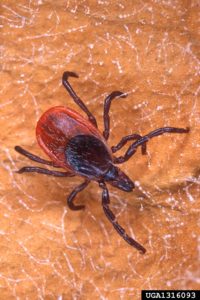Bill McNee, forest health specialist, Oshkosh, Bill.McNee@wisconsin.gov or 920-360-0942

Adult deer tick. Credit: Scott Bauer, USDA Agricultural Research Service, bugwood.org.
So far this spring we are off to a busy tick season, with many reports and photos being sent in to DNR staff. Ticks can be found year-round in Wisconsin but are most active from May to September. Some species, including the deer tick responsible for Lyme disease, carry infectious diseases that elevate them from mere nuisance to serious health threat. Lyme disease is most often spread by very small, immature ticks known as “nymphs.” Adult deer ticks can also transmit Lyme disease, but because they are larger, they are more likely to be discovered and removed compared to the tiny nymphs which can be as small as a chia or sesame seed.
The Wisconsin Department of Health Services says that the number of Lyme disease reports has more than doubled in Wisconsin over the past decade. Wisconsinites reported 3,000 cases of Lyme disease last year, and these numbers are expected to be just a fraction of the total number of cases. A county-level map showing the incidence of Lyme disease and other tick-borne diseases can be seen here.
You can take steps to “fight the bite,” and reduce the likelihood of getting a tick-borne disease, by using personal protection, removing ticks as soon as possible and keeping ticks out of yards and homes. Detailed information and recommendations have been developed by the Wisconsin Department of Health Services and are available online. See a summary of their recommendations below:
- Properly apply tick repellents and pesticides on skin and clothing.
- Wear light-colored clothing and long-sleeved shirts.Tuck in clothing so that crawling ticks are less likely to get underneath.
- Where practical, avoid wooded and brushy areas with tall grass and leaf litter. Stay in the middle of trails.
- Carefully check yourself and children for ticks after being outdoors. A bath or shower will help to remove crawling ticks.
- Kill any ticks that may still be on clothing. Tumble dry clothes in a dryer on high heat for 10 minutes. If clothes are damp, tumble dry on high heat for 60 minutes.
- Try to prevent pets from bringing ticks indoors. Keep them out of tick habitat and use appropriate tick prevention products.
If you find an embedded tick on your body, the Department of Health Services recommends that you remove it as quickly as possible using the tick removal dos and don’ts on their website. Note that these recommendations discourage the use of petroleum jelly, hot matches, nail polish or other topical products. Take special care not to squeeze, crush or puncture the tick as doing so may release infectious fluids. After removing the tick, clean the area with rubbing alcohol and wash your hands. Monitor yourself for symptoms such as rash, fever or other flu-like symptoms within the first 30 days and see a doctor immediately if they arise.
Information source used: Wisconsin Department of Health Services website, https://www.dhs.wisconsin.gov/tick/lyme.htm. This article is not intended to be medical advice provided by the Wisconsin Department of Natural Resources. Consult a medical professional for medical advice.
